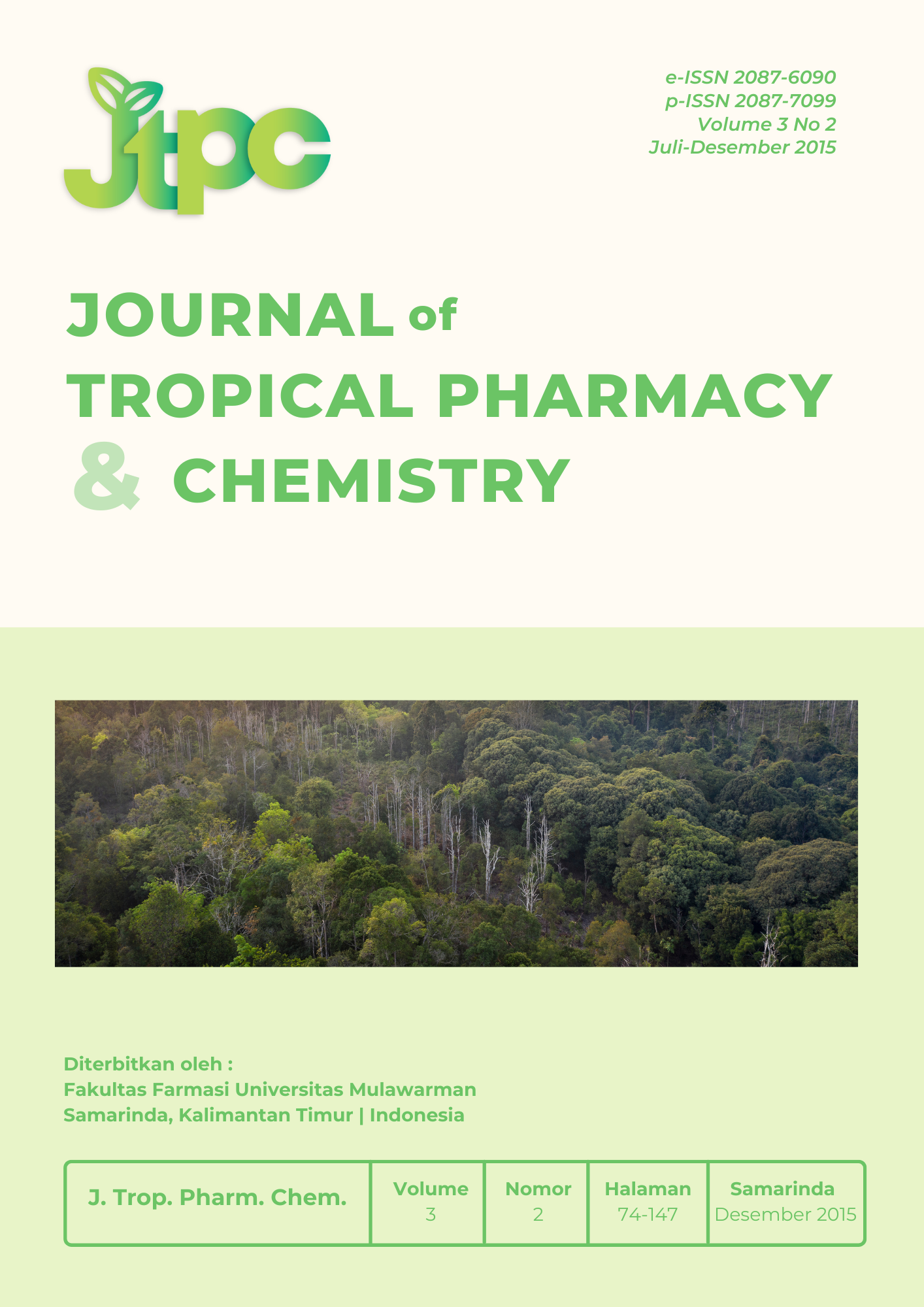Formulasi dan Optimasi Basis Gel HPMC (Hidroxy Propyl Methyl Cellulose) dengan Berbagai Variasi Konsentrasi
Keywords:
Gel, HPMC (hidroxy propyl methyl cellulose), gelling agent.Abstract
Ideal gel formulation can be obtained by formulating some kind of gelling material, but the most important thing to note is the selection of a gelling agent. HPMC (Hidroxy Propyl Methyl Cellulose) is a gelling agent that is commonly used in the production of cosmetics and drugs, because it can producea gel that is clear, easily soluble in water, and has a low toxicity. This study aimed to obtain the concentration of HPMC as a gelling agent that has the physical stability in accordance with the stipulated requirements. Gel formulations made with HPMC concentration variation of 3%, 5% and 7%, further evaluation of physical properties include organoleptic test, homogeneity, dispersive power, pH, and viscosity. Evaluation gel base done for 3 weeks. The results of stability tests show the base gel with a concentration of 7% HPMC has a good standard for viscosity, pH, dispersive power, homogeneity and organoleptic.
Downloads
References
1.Madan, J., dan Singh, R. 2010. Formulation and Evaluation of Aloevera Topical Gels. Int.J.Ph.Sci. 2(2). 551-555.
2.Setyaningrum, N.L. 2013. Pengaruh Variasi Kadar Basis HPMC Dalam
Sediaan Gel Ekstrak Etanolik Bunga Kembang Sepatu (Hibiscus rosa sinensis
L.) Terhadap Sifat Fisika dan Daya Antibakteri pada Staphylococcus aureus.
Naskah Publikasi. Fakutas Farmasi Universitas Muhammadiyah Surakarta.
3.Arikaumala, J., Dewantara, I.G.N.A., dan Wijayanti, N.P.A.D. 2013. Optimasi HPMC Sebagai Gelling AgentDalam Formula Gel Ekstrak Kulit Buah Manggis (Garcinia mangostanL.). Jurnal Farmasi Udayana. Jurusan Farmasi Fakultas Matematika dan Ilmu Pengetahuan Alam Universitas Udayana. Bali.
4.Suardi, M., Armenia dan Anita, M. 2008. Formulasi dan Uji Klinik Gel Ant
ijerawat Benzoil Peroksida-HPMC. Skripsi. Fakultas Farmasi Universitas Udayana. Denpasar.
5.Rawlins, E.A. 2003. Bentleys of Pharmaceutics. Edisi Kedelapanbelas. Baillierre Tindal. London. Hal 22-35.
6.Tranggono, Retno, I., Latifah,Fatmah.
2007. Buku Pegangan Ilmu Pengetahuan Kosmetik. PT. Gramrdia
Pustaka Utama. Jakarta.
7.Ansari, S.A. 2009. Skin pH and Skin Flora. In Handbook of Cosmetics Science and Technology. Edisi Ketiga. Informa Healtcare USA. New York.
Hal 222-223.
8.Astuti I. Y., D. Hartanti, dan A. Aminiati. 2010. Peningkatan Aktivitas AntijamurCandida albicans Salep Minyak Atsiri Daun Sirih(Piper bettle L.) Melalui Pembentukan Kompleks Inklusi denganβ-siklodekstrin. Majalah Obat Tradisional. 15: 94-99.
9.Garg, A., Aggarwal, D., Garg, S., dan Sigla, A.K. 2002. Spreading of Semisolid Formulation: An Update. Pharmaceutical Tecnology. 84-102.
10.Anonim. 1985. Formularium Kosmetika Indonesia. Dapertemen Kesehatan RI. Jakarta.
11.Ansel, H.C. 1989.
Penghantar Bentuk Sediaan Farmasi.Edisi 4. Penerjemah: Farida Ibrahim. UI Press. Hal. 390-391.
12.Ida, N., dan Noer, S.F. 2012. Uji Stabilitas Fisik Gel Ekstrak Lidah Buaya (Aloe vera L.). Majalah Farmasi dan Farmakologi. 16(2). 79-84
13.Martin, A.J.S., Swarbrick, dan Cammarata, A. 1993. Farmasi Fisika. Edisi 3, diterjemahkan oleh Yoshita. UI-Press. Jakarta.
14.Barel, A. O., M.Paye,dan H. I. Maibach. 2009. Handbook of Cosmetic Science and Technology. Third Edition. Informa Healthcare USA, Inc. New York. 233, 261-262.
15.Rowe, R. C., Sheskey, P. J., and Quinn, M. E. 2009. Handbook of Pharmaceutical Excipients. Sixth Edition. Pharmaceutical Press. London.
16.Anonim. 1979. Farmakope Indonesia. Edisi Ketiga. Dapertemen Kesehatan Indonesia. Jakarta.
17.Wyatt, E. L., Sutter, S. H., dan Drake, L. A. 2008. Dermatology Pharmacology; In Hardaman, J. G., Limbird, L. E., dan Gilman, A. G. (eds),
Gilman’sthe Parmacological Basis of Therapeutics. 10th edition. 1763. McGraw-Hill. New York.
18.Erawati, T., Rosita, N., Hendroprasetyo, W., danJuwita, D. R., 2005, Pengaruh Jenis Basis Gel Dan Penambahan NaCl (0.5% -b/b) Terhadap Intensitas Echo Gelombang Ultrasonik Sediaan Gel Untuk Pemeriksaan USG (Acoustic Coupling Agent). Airlangga Journal of Pharmacy, 5(2)




